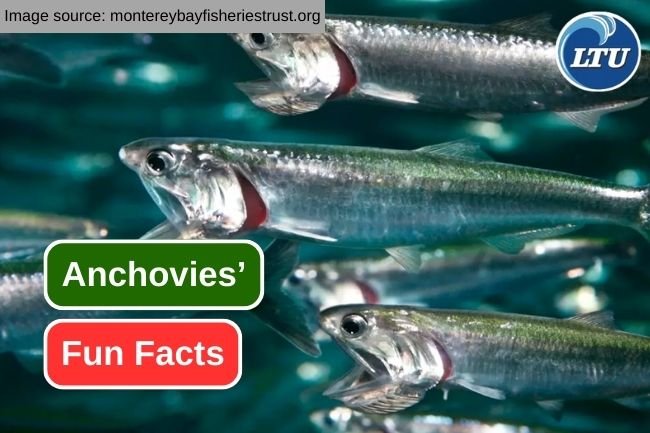
Think of anchovies like the secret ingredient in a culinary magician’s toolkit. They can turn a simple pasta dish into a gourmet meal with their umami punch. Whether you’re a chef, a foodie, or just someone who loves to eat, knowing more about these fish can add an exciting twist to your cooking adventures. So, let’s dive into the world of anchovies and uncover ten fascinating facts!
1. Tiny But Mighty: The Anchovy’s Role in Ecosystems
Anchovies are small fish, typically measuring just a few inches long. Despite their size, they play a crucial role in marine ecosystems. Think of them as the unsung heroes of the ocean! They serve as a primary food source for larger fish, seabirds, and even marine mammals. By consuming plankton and other tiny organisms, anchovies help maintain the balance of the ocean’s food web.
Understanding anchovies’ role in the ecosystem is vital. They help control plankton populations, which in turn affects the overall health of ocean environments. When anchovy populations fluctuate, it can have a ripple effect on the entire ecosystem, influencing everything from fish populations to seabird nesting success.
In regions like the Pacific Ocean, anchovy schools can be so massive that they’re visible from the air! Imagine millions of these tiny fish glimmering in the sunlight, creating a spectacular show in the water.
2. Anchovies: A Culinary Gem
Anchovies might not be the main star of the seafood department, but in the culinary world, they’re nothing short of a gem. These fish have a unique umami flavor that chefs adore. They’re often used in dishes like Caesar salads, Italian pasta sauces, and even pizza.
When you see anchovies on a menu, you might wonder if they’re a whole fish or just a flavorful paste. Here’s a fun fact for you: anchovy paste is made from anchovies that have been purified and mixed with oil. This makes it super easy to incorporate the bold flavor into your cooking without having to deal with the whole fish.
Plus, anchovies are incredibly versatile! You can use them in dressings, sauces, or even as a topping. Just remember, a little goes a long way! You might be surprised at how they can elevate the flavors of your favorite dishes.
3. Anchovies in History: A Timeless Ingredient
Did you know that anchovies have been enjoyed for thousands of years? The ancient Greeks and Romans were big fans, and they used them in various dishes. In fact, the famous Roman cookbook, *Apicius*, contains recipes that call for anchovies. They were so popular that they were often salted and preserved to enjoy throughout the year.
Fast forward to today, and anchovies still hold a special place in many cuisines worldwide. In Mediterranean cooking, for example, they’re often used not just for flavor but also for their nutritional benefits. Anchovies are rich in omega-3 fatty acids, protein, and essential vitamins. They come with a side of history, flavor, and nutrition!
This little fish’s enduring popularity shows how timeless ingredients can adapt through the ages while remaining relevant in modern cooking.
4. The Anchovy’s Nutritional Benefits
You might not expect such a small fish to pack a nutritional punch, but anchovies are surprisingly healthy! They’re high in protein and low in calories, making them a fantastic option for those looking to boost their diet without adding unwanted calories. Just a small serving can give you a solid amount of important nutrients.
Anchovies are also loaded with omega-3 fatty acids, which are great for heart health. These healthy fats can help lower blood pressure and reduce the risk of cardiovascular diseases. Eating anchovies can also provide you with essential vitamins and minerals, such as vitamin B12, calcium, and iron.
So, if you’re looking for a nutritious way to add flavor to your meals, anchovies could be your new best friend. They’re not just tasty; they’re good for you, too!
5. Sustainable Fishing Practices
As with many seafood options, sustainability is essential when it comes to anchovies. Overfishing has been a significant concern for various fish populations, and anchovies are no exception. However, many fisheries are now adopting sustainable fishing practices to help ensure that anchovy populations remain healthy.
When shopping for anchovies, look for products labeled as “sustainably sourced.” This label often indicates that the fish were caught in a way that supports the ecosystem and helps prevent overfishing. Sustainability in seafood isn’t just about the fish; it also considers the health of the oceans and the communities that depend on them.
By choosing sustainably sourced anchovies, you’re making a positive impact on marine life and supporting responsible fishing practices.
6. Anchovies Versus Sardines: What’s the Difference?
You might have noticed anchovies and sardines next to each other in the seafood aisle and wondered how they differ. While they’re both small fish popular in various cuisines, they belong to different family groups. Anchovies are part of the Engraulidae family, while sardines belong to the Clupeidae family.
Taste-wise, anchovies have a stronger, saltier flavor, while sardines tend to be milder and a bit meatier. When it comes to preparation, anchovies are often used as a flavor enhancer in sauces and dressings, whereas sardines can be enjoyed whole or added to salads and sandwiches.
Both fish are nutritious and delicious, but the key difference lies in their flavor profiles and culinary uses. If you’re ever in doubt, think about what flavor you want to bring to the table!
7. Anchovies in Pop Culture
It’s not just the culinary world where anchovies make their mark; they’ve also slipped into pop culture! You might remember a famous scene in *The Simpsons* where Lisa becomes a vegetarian and struggles with the idea of anchovies on pizza. This humorous take highlights the fish’s unique flavor and how polarizing it can be among diners.
Gaining traction in various documentaries, anchovies have shown up in discussions about sustainability, culinary arts, and nutrition. They’ve even made appearances in cookbooks that celebrate their flavor and versatility.
So, the next time you hear someone debating anchovies, you’ll know that this little fish is more than just a food item—it’s part of our cultural conversations too!
8. The Science Behind Anchovy Flavor
Ever wonder what gives anchovies their distinctive flavor? It all comes down to a compound called inosinate. This amino acid is what gives these fish their umami taste. You might be surprised to learn that umami is often described as the “fifth taste,” along with sweet, sour, bitter, and salty.
When anchovies are cured and fermented, they develop even more rich flavors, enhancing their taste profile. This transformation is what makes them a favorite for chefs looking to add depth to their dishes. It’s like a flavor party in a tiny fish!
Want to really appreciate their flavor? Try using anchovy pastes or fillets in sauces. You’ll be amazed at how a small amount can dramatically enhance your meal.
9. How to Store Anchovies for Freshness
If you’ve ever bought a can of anchovies, you might wonder about the best way to store them. Here’s the thing: anchovies can be pretty forgiving when it comes to storage if you know what to do! Once opened, store them in an airtight container in the fridge.
If you have leftover anchovies in oil, you can keep them submerged in that oil. This not only helps preserve their flavor but also adds richness if you use it in cooking later. Just remember to consume them within a few weeks for the best taste!
Feeling adventurous? You can also freeze anchovies to extend their shelf life. Just make sure to separate them in a container or freezer bag to prevent clumping.
10. Anchovy Substitutes for Cooking
Maybe you’re in the mood for a flavorful dish but don’t have any anchovies on hand. Don’t worry! There are some great substitutes that can work in a pinch. Here are a few options to consider:
- Capers: These little briny buds have a tangy flavor and can mimic the salty kick of anchovies.
- Dried seaweed: Seaweed can provide a similar umami flavor, especially in Asian-inspired dishes.
- Miso paste: This fermented soybean paste gives a rich, savory taste that can replace anchovies in sauces.
- Olives: Chopped olives can also add a salty flavor and texture to your recipes.
While these substitutions offer a different twist, they can still enhance your dishes without feeling like you’re missing out on the anchovy goodness.
Ultimately, it’s all about experimenting! Cooking is about finding flavors that work for you, and sometimes stepping outside the box can lead to delicious surprises.
In conclusion, the anchovy is so much more than just a small fish; it’s a fascinating ingredient with a rich history, diverse culinary uses, and a strong nutritional profile. Whether you’re adding them to a dish for flavor or learning about sustainable practices, anchovies have earned their place on our plates. So next time you’re at the store, consider giving these little fish a try—you might just discover a new favorite!

